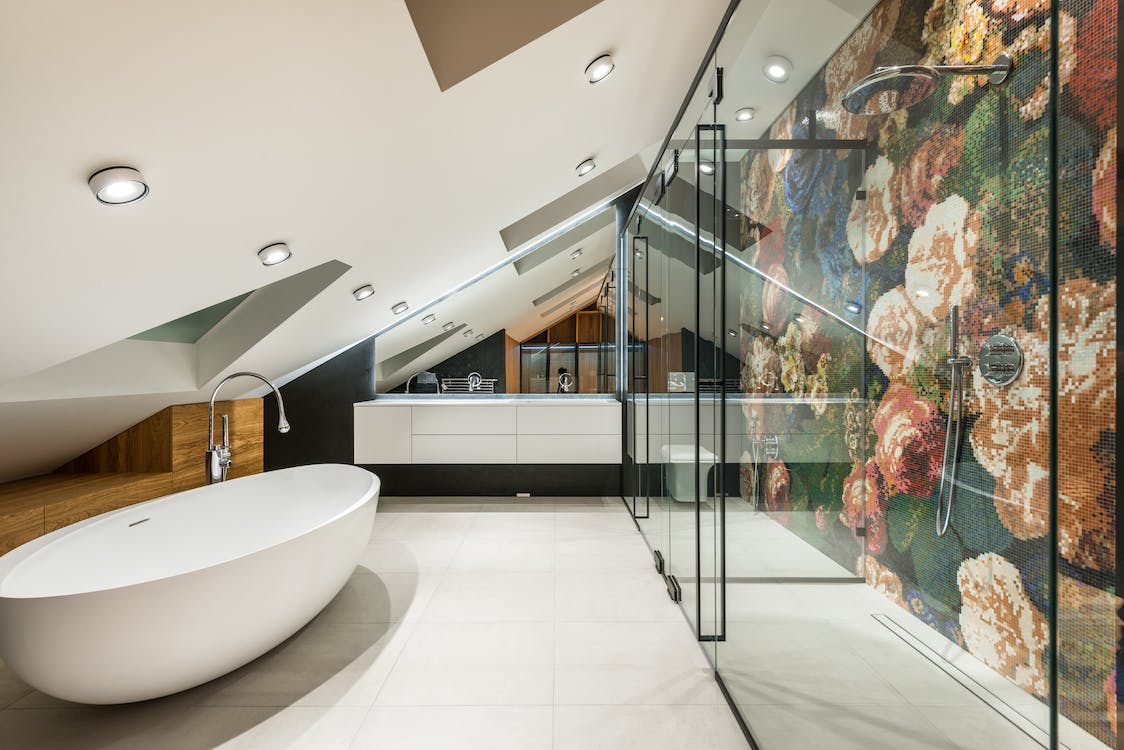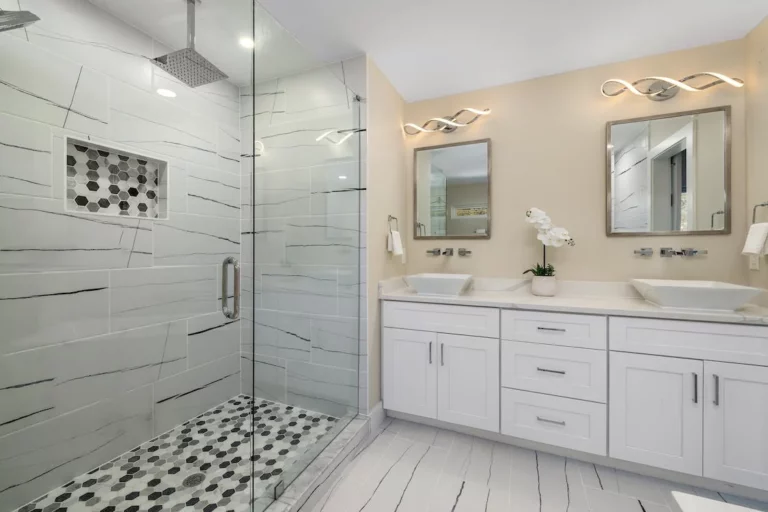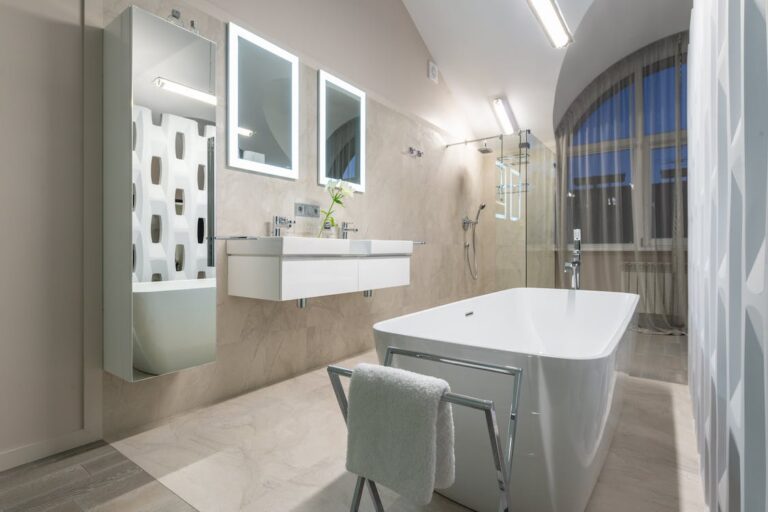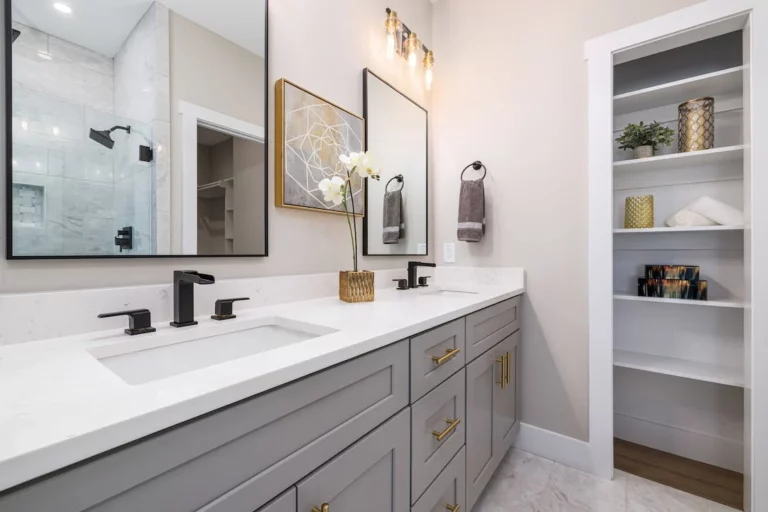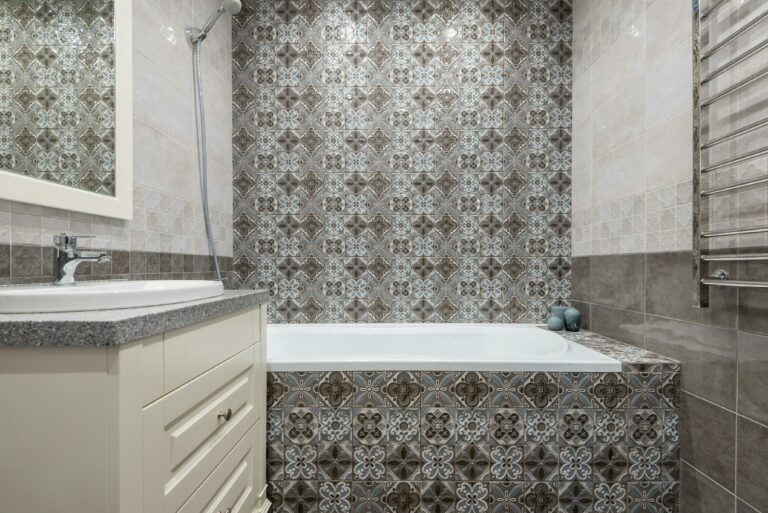Transforming Your Bathroom : Design Ideas for a Fresh Start in 2023
Welcome to “Transforming Your Bathroom: Design Ideas for a Fresh Start.” Your bathroom is one of the most important spaces in your home. It’s where you start and end your day, making it essential to create a comfortable and stylish environment that suits your needs and preferences. Whether you’re looking to update your bathroom’s look or completely renovate the space, this article will provide you with expert tips and bathroom design ideas to help you get started.
Table of Contents
- 0.1 Transforming Your Bathroom
- 0.2 Assessing Your Current Bathroom
- 0.3 Setting a Budget
- 0.4 Choosing a Style and Theme
- 0.5 Bathroom Layout and Floor Plan
- 0.6 Color Palette and Materials
- 0.7 Lighting and Ventilation
- 0.8 Storage Solutions
- 0.9 Choosing Fixtures and Fittings
- 0.10 Flooring and Wall Decor
- 0.11 Finishing Touches
- 1 Conclusion
Transforming Your Bathroom
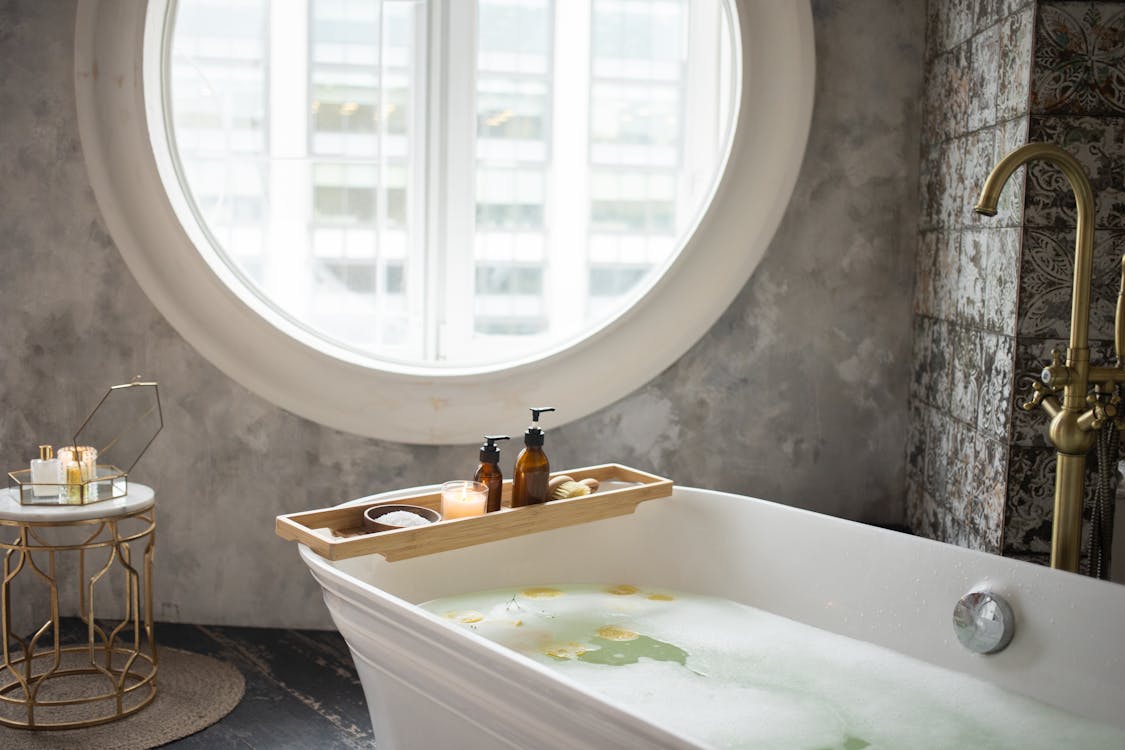
Transforming your bathroom design can be an exciting project that adds value to your home. However, it can also be overwhelming with all the choices and decisions to make. That’s why we’re here to guide you through the process, step by step, and share our knowledge and insights to make your bathroom transformation a success.
By the end of this article, you’ll have the knowledge and inspiration to transform your bathroom design into a stylish and functional space that reflects your personal taste. Let’s get started on this exciting journey of bathroom design transformation!
Assessing Your Current Bathroom

When it comes to transforming your bathroom, it’s important to start by assessing your current space. This will help you identify any problem areas and determine what changes need to be made. Here are some key steps to take when evaluating your bathroom:
Evaluate the Space and Layout
Take a close look at the overall space and layout of your bathroom. Consider the dimensions, shape, and any architectural features that may impact the design. Ask yourself the following questions:
- Is the layout functional and efficient?
- Is there enough space to move around comfortably?
- Are there any awkward corners or wasted areas?
By understanding the limitations and potential of your space, you can make better decisions when it comes to the layout of your new bathroom design.
Identify Problem Areas
Next, identify any problem areas in your current bathroom. This could include issues such as:
- Outdated fixtures or fittings
- Limited storage space
- Poor ventilation or lighting
- Inadequate plumbing
Take note of these problem areas and prioritize them based on their impact on your daily use of the bathroom. This will help you focus your efforts on the most important aspects of the renovation.
Consider Your Needs and Preferences
It’s crucial to consider your own needs and preferences when assessing your current bathroom design. Think about how you use the space and what features are important to you. Ask yourself:
- Do you require a bathtub or would a shower suffice?
- How much storage do you need?
- Do you prefer a minimalist or more ornate style?
Understanding your own preferences will guide you in making decisions that align with your lifestyle and taste.
Remember, the assessment phase is all about understanding your current bathroom and envisioning how it can be improved. By taking the time to assess your space, you’ll be better equipped to create a design that meets your needs and transforms your bathroom into a space you’ll love.
Setting a Budget
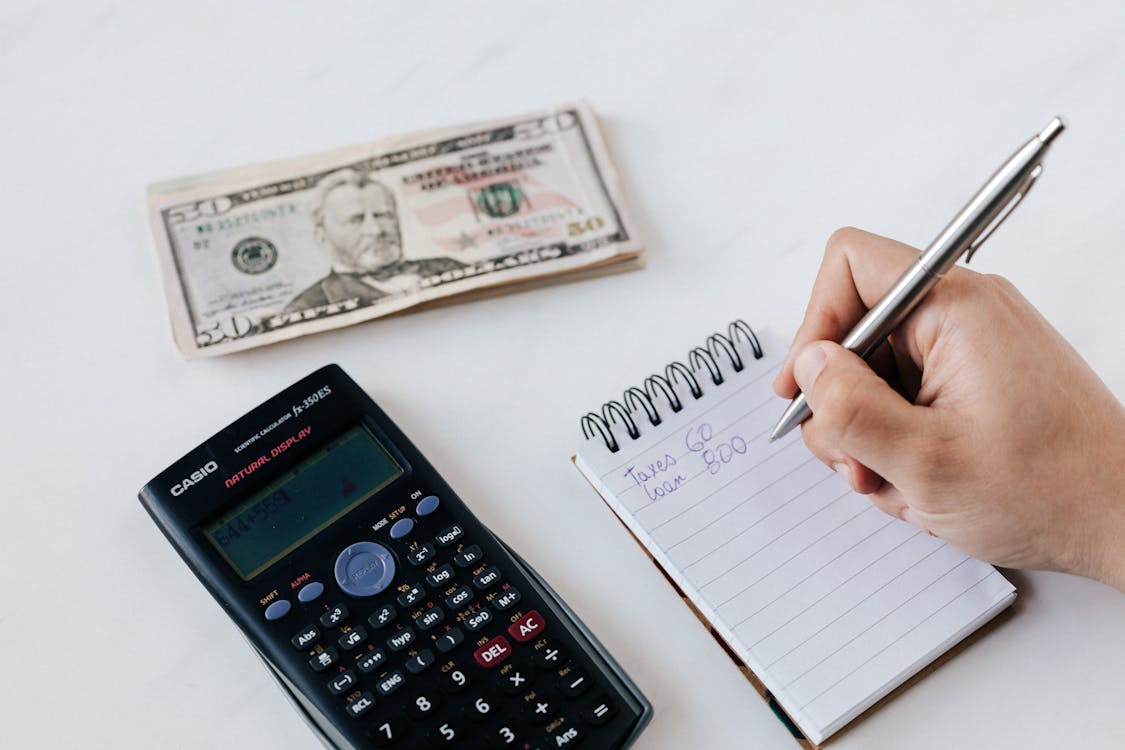
One of the most important things to consider when transforming your bathroom is setting a budget. Renovations can quickly become costly, so it’s crucial to determine your budget limit before diving into the project. Here are some steps to help you set a budget for your bathroom renovation:
Determining Your Budget Limit
- Evaluate your financial situation and determine how much you can realistically afford to spend on your bathroom renovation.
- Consider other expenses you may have during the renovation process, such as hiring contractors, purchasing materials, and permits.
- Set a budget limit that you are comfortable with and ensure it aligns with your overall financial goals.
Prioritizing Design Elements
- Make a list of the essential design elements you want to include in your new bathroom. This could include fixtures, fittings, materials, and any additional features.
- Prioritize the elements on your list and allocate a portion of your budget to each one. This will help you decide where to invest more money and where you can save.
- Remember to consider the long-term functionality and durability of the design elements you choose. It’s important to strike a balance between aesthetics and practicality.
Researching Price Ranges
- Research the average prices of the design elements you have prioritized. This will give you a better idea of how much you can expect to spend on each item.
- Look for deals, discounts, and sales to help you save money on materials and fixtures. It’s also worth comparing prices from different suppliers to ensure you’re getting the best value for your money.
- Don’t forget to account for labor costs if you plan on hiring professionals to help with the renovation. Obtain multiple quotes from reputable contractors to ensure you’re getting a fair price.
Setting a budget for your bathroom renovation involves careful consideration and planning. It’s essential to allocate your funds wisely and prioritize the design elements that are most important to you. By doing thorough research and being mindful of your budget limit, you can create a beautiful and functional bathroom design without breaking the bank.
Choosing a Style and Theme

When it comes to transforming your bathroom, one of the most exciting decisions you’ll make is choosing a style and theme for your space. The style and theme you choose will set the overall tone and mood for your bathroom, so it’s important to choose something that not only fits your personal taste but also complements the rest of your home’s aesthetic. Here are some tips to help you make the right choice:
Exploring Different Bathroom Styles
There are numerous bathroom styles to choose from, ranging from modern and contemporary to rustic and traditional. Take some time to explore different styles and see which ones resonate with you. Look for inspiration in home decor magazines, online galleries, and even in hotels or vacation rentals you’ve visited. Remember, your bathroom design should be a reflection of your personal style, so don’t be afraid to be bold and unique.
Considering Your Home’s Overall Aesthetic
While it’s important to choose a style that you love, it’s also crucial to consider your home’s overall aesthetic. You want your bathroom to flow seamlessly with the rest of your home, creating a cohesive and harmonious look. If your home has a modern and minimalist vibe, a sleek and contemporary bathroom style might be the way to go. On the other hand, if your home has a more traditional and vintage feel, a rustic or Victorian-inspired bathroom might be a better fit.
Selecting a Theme
Once you’ve settled on a style, it’s time to choose a theme that will bring your bathroom to life. A theme can help add personality and character to your space, making it feel more unique and inviting. Some popular bathroom themes include:
- Nautical: Create a coastal getaway in your bathroom with a nautical theme. Think striped wallpapers, seashell accents, and light blue or navy color schemes.
- Spa: Transform your bathroom into a spa-like oasis with calming colors, natural materials, and luxurious touches like bamboo bath mats and scented candles.
- Vintage: Embrace the charm of the past with a vintage-inspired bathroom theme. Antique fixtures, clawfoot bathtubs, and vintage wallpaper patterns can help create a nostalgic and elegant look.
- Scandinavian: Create a clean and minimalist bathroom inspired by Scandinavian design. Use light colors, natural materials, and simple lines to achieve a serene and clutter-free space.
Remember, the style and theme you choose should align with your personal taste and preferences. Don’t be afraid to think outside the box and get creative with your design choices.
“Your bathroom is your sanctuary, and choosing the right style and theme can make a huge difference in creating a space that you love and enjoy spending time in. Take the time to explore different styles, consider your home’s overall aesthetic, and select a theme that resonates with your personality. With the right style and theme, your bathroom will become the ultimate retreat and a reflection of your unique style.”
Bathroom Layout and Floor Plan
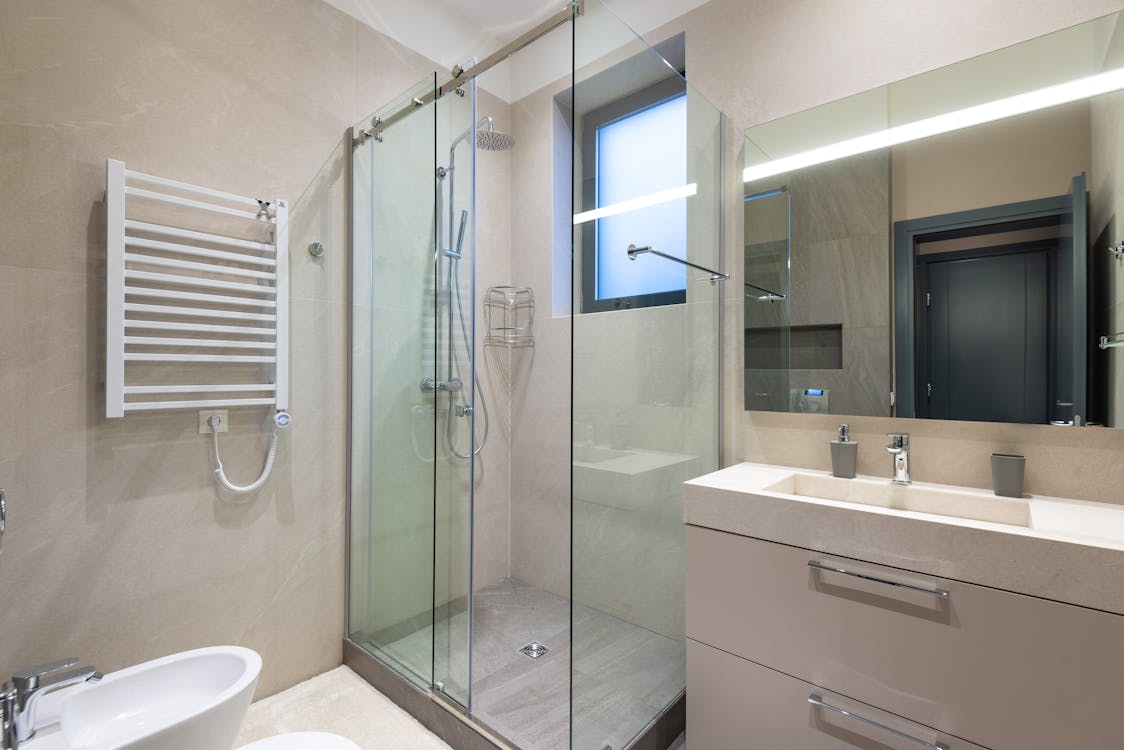
When it comes to bathroom designs, the layout and floor plan are crucial elements to consider. A well-thought-out layout can maximize the functionality of your space and ensure that it meets your specific needs. So, let’s dive in and explore some key factors to consider when planning your bathroom layout and floor plan.
Optimizing the Space
The first step in creating an effective bathroom layout is to optimize the available space. Here are some tips to make the most of your bathroom’s square footage:
- Consider the traffic flow: Ensure that there is enough space for people to move around comfortably without any obstructions.
- Placement of fixtures: Strategically position the sink, toilet, and shower/bathtub in a way that maximizes the available space while allowing for easy accessibility.
- Allocate space for storage: Prioritize including enough storage options, such as cabinets or shelves, while still keeping the overall layout open and spacious.
Deciding on Fixtures and Fittings
Once you have a rough idea of your bathroom’s layout, it’s time to decide on the fixtures and fittings. Consider the following factors:
- Size of fixtures: Choose appropriately sized fixtures that fit seamlessly into your bathroom’s layout without overwhelming the space.
- Functionality: Consider the different functions of each fixture and how they will be used. For example, a counter space next to the sink can provide a convenient area for toiletries, while a walk-in shower may be more practical for those with mobility issues.
- Water and drainage points: Plan the location of water and drainage points for fixtures, such as sinks, toilets, and showers, based on your existing plumbing system.
Plumbing Considerations
When designing your bathroom layout, it’s important to work around your existing plumbing infrastructure. Consider the following plumbing considerations:
- Cost and complexity: Relocating pipes and drainage can significantly increase the complexity and cost of your bathroom renovation project. If possible, try to work with the existing plumbing to save time and money.
- Water supply: Ensure that your bathroom layout allows for easy access to the main water supply and that the piping is properly insulated to prevent freezing during colder months.
- Ventilation: Proper ventilation is essential to prevent moisture buildup and potential mold or mildew growth. Plan for the installation of an exhaust fan or a window to ensure proper airflow.
By considering these factors, you can create a bathroom layout and floor plan that not only looks aesthetically pleasing but also functions well for your specific needs. Remember to prioritize practicality and efficiency while still incorporating your personal style. Happy designing!
Readers’ Tip: “When designing your bathroom layout, think about the future. Consider factors such as aging in place or accommodating any potential mobility issues. Designing a bathroom that is adaptable can save you time and money in the long run.”
Color Palette and Materials

When it comes to transforming your bathroom, one of the most important aspects to consider is the color palette and materials. The colors and materials you choose can greatly impact the overall look and feel of your bathroom design. Here are some tips to help you make the right choices:
Picking a Color Scheme
- Neutral colors like white, beige, and gray are timeless options that create a clean and fresh look in the bathroom.
- Bold and vibrant colors can add personality and make a statement in your bathroom design. Consider using them as accent colors or on a feature wall.
- Pastel colors like light blue, soft pink, or mint green can create a calming and relaxing atmosphere.
- Monochromatic color schemes can be achieved by using different shades of the same color. This creates a cohesive and harmonious look.
- Contrasting colors can create visual interest and add vibrancy to your bathroom. For example, pairing navy blue with white or yellow with gray.
The color scheme you choose should depend on your personal preferences and the overall style and theme of your bathroom.
Selecting Suitable Materials
When it comes to bathroom design materials, it’s important to choose options that are both practical and visually appealing. Here are some considerations:
- Flooring materials: Choose materials that are durable, water-resistant, and easy to clean. Options include ceramic or porcelain tiles, vinyl, or waterproof laminate flooring.
- Wall materials: Tiles are a popular choice for bathroom walls due to their water resistance. You can opt for ceramic, porcelain, or glass tiles in various colors, patterns, and sizes.
- Countertop materials: Consider materials like granite, quartz, or solid surface for your bathroom countertop. These materials are durable, stain-resistant, and easy to maintain.
- Cabinet materials: Wood or moisture-resistant materials like marine-grade plywood or acrylic are ideal for bathroom cabinets. Make sure they can withstand the humid environment.
- Shower and bath materials: Fiberglass, acrylic, or porcelain options are common for showers and bathtubs. Look for materials that are easy to clean and resistant to stains and mold.
Balancing Style and Practicality
When choosing materials for your bathroom design, it’s important to find a balance between style and practicality. Consider the following:
- Durability: Choose materials that can withstand moisture, frequent cleaning, and daily use without deteriorating or showing signs of wear and tear.
- Maintenance: Select materials that are easy to clean and maintain. Avoid materials that require special cleaning products or regular sealing.
- Functionality: Consider the functionality of the materials. For example, textured floor tiles can provide better slip resistance, while matte-finish tiles can hide watermarks and fingerprints.
- Aesthetics: Choose materials that complement your chosen color scheme and overall bathroom design. Consider textures, patterns, and finishes that create the desired atmosphere.
By carefully selecting the right color palette and materials for your bathroom design, you can create a space that is not only visually appealing but also functional and enjoyable to use. Remember to consider your personal preferences, the overall style of your home, and the practicality of the materials you choose.
Also Read: Bathroom Renovation Dos and Don’ts : Expert Advice for Homeowners in 2023
Lighting and Ventilation

When it comes to bathroom designs, lighting and ventilation are two crucial elements that should not be overlooked. A well-lit and well-ventilated bathroom not only enhances the overall appearance and comfort of the space but also contributes to the health and well-being of those who use it. In this section, we will explore some key considerations when it comes to lighting and ventilation in your bathroom design.
Enhancing Natural Lighting
- Natural lighting can bring a sense of warmth and freshness to the bathroom. Consider incorporating windows or skylights to maximize the amount of natural light that enters the space.
- Pay attention to the orientation of the windows to ensure that the bathroom receives optimal sunlight throughout the day.
- If privacy is a concern, consider using frosted or textured glass for the windows or installing window coverings that allow light to pass through while still maintaining privacy.
Choosing Appropriate Light Fixtures
- When selecting light fixtures for your bathroom design, it’s important to strike a balance between functionality and aesthetics.
- Start by considering the different areas of your bathroom that require adequate lighting, such as the vanity area, shower, and bathtub.
- Vanity lighting is crucial for tasks such as applying makeup or shaving. Consider installing sconces or vertical strip lights on either side of the vanity mirror to minimize shadows on the face.
- In the shower or bathtub area, opt for water-resistant light fixtures that can withstand the moisture and humidity.
Improving Ventilation
- Proper ventilation plays a crucial role in maintaining a clean and healthy bathroom environment. It helps to remove excess moisture and odors, preventing the growth of mold and mildew.
- One of the simplest ways to improve ventilation is by installing an exhaust fan. Ensure that the fan is adequately sized for your bathroom’s square footage to effectively remove moisture and odors.
- Consider the noise level of the exhaust fan and choose one with a low noise rating to avoid any disturbances during your bathroom routine.
- If possible, position the exhaust fan near the shower or bathtub area to effectively remove steam and moisture.
By paying attention to the lighting and ventilation in your bathroom design, you can create a comfortable and enjoyable space that meets your functional and aesthetic needs. Remember to incorporate natural light, choose appropriate light fixtures, and ensure proper ventilation to transform your bathroom design into a bright and refreshing oasis.
Storage Solutions

When it comes to bathroom designs, one of the most important aspects to consider is storage. A well-organized and clutter-free space can make a huge difference in the functionality and overall look of your bathroom. Whether you have a small bathroom or a spacious one, implementing smart storage solutions will help maximize your space and keep everything neat and tidy.
Here are some storage ideas to consider when transforming your bathroom:
Maximizing Storage Space
- Floating Shelves: Installing floating shelves on the walls is a great way to add extra storage without taking up floor space. You can use them to store towels, toiletries, and decorative items.
- Under-Sink Cabinets: Utilizing the space under the sink is essential for storage in a bathroom. Install cabinets or drawers to keep cleaning supplies, extra toilet paper, and other essential bathroom items.
- Vertical Storage: If you have limited floor space, consider using vertical storage solutions such as tall cabinets or shelving units. These can provide ample storage while taking up minimal space.
- Over-the-Toilet Storage: Another clever storage solution is using the space above your toilet. Install shelves or cabinets above the tank to store towels, toiletries, and other bathroom essentials.
- Baskets and Bins: Using baskets and bins can help keep your bathroom organized and visually appealing. Use them to store items like towels, toilet paper, or even hair accessories.
Clever Organization Ideas
- Drawer Dividers: Use drawer dividers to keep your bathroom essentials neatly organized and easily accessible. Separate items like makeup, hair tools, and grooming products for efficient storage.
- Magnetic Strips: Attach magnetic strips to the inside of cabinet doors to hold metal tools like tweezers, nail clippers, and bobby pins.
- Wall Hooks: Install wall hooks to hang towels, robes, or clothing. They can also be used to hang baskets or organizers for additional storage.
- Tiered Trays: Opt for tiered trays on your countertop to maximize the use of vertical space. They are perfect for storing smaller items like cosmetics, perfumes, and jewelry.
- Caddy or Shower Organizer: Keep your shower essentials within reach by using a caddy or shower organizer. These can be hung on the showerhead or attached to the wall to store shampoo, conditioner, and body wash.
Incorporating Stylish Storage Units
- Medicine Cabinets: Adding a medicine cabinet not only provides ample storage for medications and toiletries, but it also serves as a mirror, saving space in your bathroom.
- Open Shelving: Open shelves can be both functional and decorative. Display your towels, plants, and decorative items on them to add a touch of personal style while keeping things organized.
- Built-in Storage: Consider incorporating built-in storage into your bathroom design. This can include niches in the shower or recessed shelves in the walls, providing discreet storage options.
- Bathroom Furniture: Invest in bathroom furniture pieces such as a vanity with drawers or a cabinet with shelves. This not only adds storage space but also adds to the overall aesthetic of your bathroom.
Remember, good storage solutions are essential for a clutter-free and functional bathroom design. By implementing these ideas, you can create a space that is not only organized but also visually appealing. So, get creative and make the most of every inch of space in your bathroom design!
Choosing Fixtures and Fittings

When it comes to transforming your bathroom, choosing the right fixtures and fittings is crucial to achieve the look and functionality you desire. From sinks and vanities to toilets and showers, every element plays a role in creating a cohesive and stylish space. Here are some tips to help you make the right choices:
Sink and Vanity Options
- Consider the size and layout of your bathroom: If you have a small bathroom, a pedestal sink or a wall-mounted sink can help save space. For larger bathrooms, a vanity with storage can be a practical choice.
- Think about your storage needs: If you have a lot of toiletries and beauty products, opt for a vanity with ample storage. You can choose from options like drawers, cabinets, or open shelves.
- Choose a style that complements your overall bathroom design: Whether you prefer a modern, contemporary, or traditional look, there are various sink and vanity options available in different styles and finishes to suit your taste.
Toilet Selection
- Consider the shape and size: Toilets come in different shapes, including round or elongated. Depending on the available space in your bathroom, determine the size that fits best.
- Look for water-saving features: Opt for toilets with dual-flush systems or low-flow options to minimize water usage and promote sustainability.
- Choose a style that matches your overall bathroom aesthetic: Whether you prefer a sleek, modern toilet or a more traditional look, there are options available in different styles and finishes to suit your design preferences.
Bathtub or Shower Choices
- Assess your needs and preferences: Consider whether you prefer a relaxing soak in a bathtub or a quick and convenient shower. This will help you determine whether you need a bathtub, a shower, or a combination of both.
- Think about space limitations: If you have a small bathroom, a shower stall can help maximize space. For larger bathrooms, you may have the luxury of a separate bathtub and shower area.
- Consider safety features: If you have children or older adults in your household, think about installing grab bars or non-slip surfaces in your bathtub or shower for added safety.
Remember, choosing fixtures and fittings is not only about aesthetics but also functionality. Prioritize what works best for you and your lifestyle. Consult with professionals or visit showrooms to explore different options and get expert advice. With careful consideration and research, you can find the perfect fixtures and fittings that will transform your bathroom design into a beautiful and functional space.
Flooring and Wall Decor
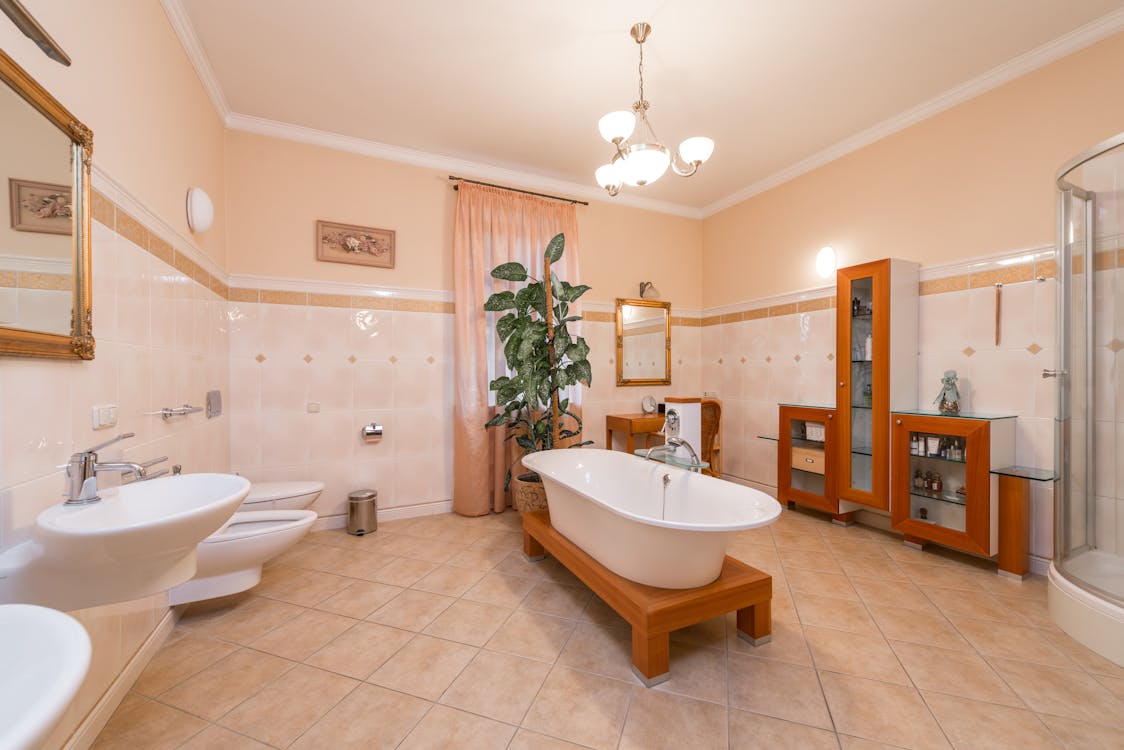
When it comes to transforming your bathroom, one important aspect to consider is the flooring and wall decor. These elements play a crucial role in setting the overall ambiance and style of your space. Whether you want a modern minimalist look or a luxurious spa-like retreat, choosing the right flooring materials and wall decor can make all the difference. Here are some tips to help you make the best choice for your bathroom:
Flooring Materials and Designs
- Tile: Tile is a popular choice for bathroom flooring due to its durability and water resistance. There are various types of tiles to choose from, including ceramic, porcelain, and natural stone. Consider the following factors when selecting tiles for your bathroom:
- Size: Larger tiles can make a small bathroom appear more spacious, while smaller tiles can create intricate patterns and textures.
- Texture: Choose tiles with a slip-resistant texture to ensure safety, especially in areas prone to moisture.
- Color: Lighter colored tiles can make a small bathroom feel brighter and more open, while darker colored tiles can add drama and sophistication.
- Vinyl: Vinyl flooring has come a long way in terms of design options and durability. It is an affordable and low-maintenance choice for bathrooms. Some advantages of vinyl flooring include:
- Water resistance: Vinyl is highly resistant to water, making it perfect for bathroom use.
- Comfort: It provides a softer and more cushioned feel underfoot compared to tiles.
- Variety: Vinyl comes in a wide range of styles, including wood, stone, and tile designs, allowing you to achieve the look you desire.
- Wood: If you want to bring warmth and elegance to your bathroom, consider using wood flooring. However, it’s important to choose a wood species that can withstand moisture and humidity. Options like engineered wood or bamboo are more suitable for bathroom use as they are less likely to warp or expand in moisture-rich environments.
Wall Decoration Ideas
When it comes to the walls, there are numerous ways to create a visually appealing and functional space:
- Tiles: Just like flooring, tiles can be used on the walls to create a cohesive look. Consider using tiles in the shower area or as an accent wall to add interest and texture to the space.
- Paint: Painting the walls is an easy and cost-effective way to change the look of your bathroom. Opt for moisture-resistant paint that can withstand the humid environment of a bathroom. Choose light, neutral colors to make the space feel larger or go bold with vibrant hues for a statement wall.
- Wallpaper: Wallpaper can add personality and charm to your bathroom. Look for wallpaper specifically designed for damp environments and choose a design that complements your chosen style and theme.
- Wainscoting or Beadboard: Adding wainscoting or beadboard to the lower half of your walls can create a classic and elegant look. This is especially effective in bathrooms with a vintage or traditional theme.
- Mirrors and Artwork: Hang a large mirror or a collection of smaller mirrors to bounce light around the room and create the illusion of more space. Incorporating artwork or framed prints can also add a personal touch and serve as a focal point in the bathroom.
Remember, the flooring and wall decor in your bathroom design should not only be aesthetically pleasing but also functional and durable. Take into account the amount of foot traffic, water exposure, and maintenance requirements when making your choices. With the right flooring materials and wall decor, you can transform your bathroom into a space that is both beautiful and functional.
Finishing Touches
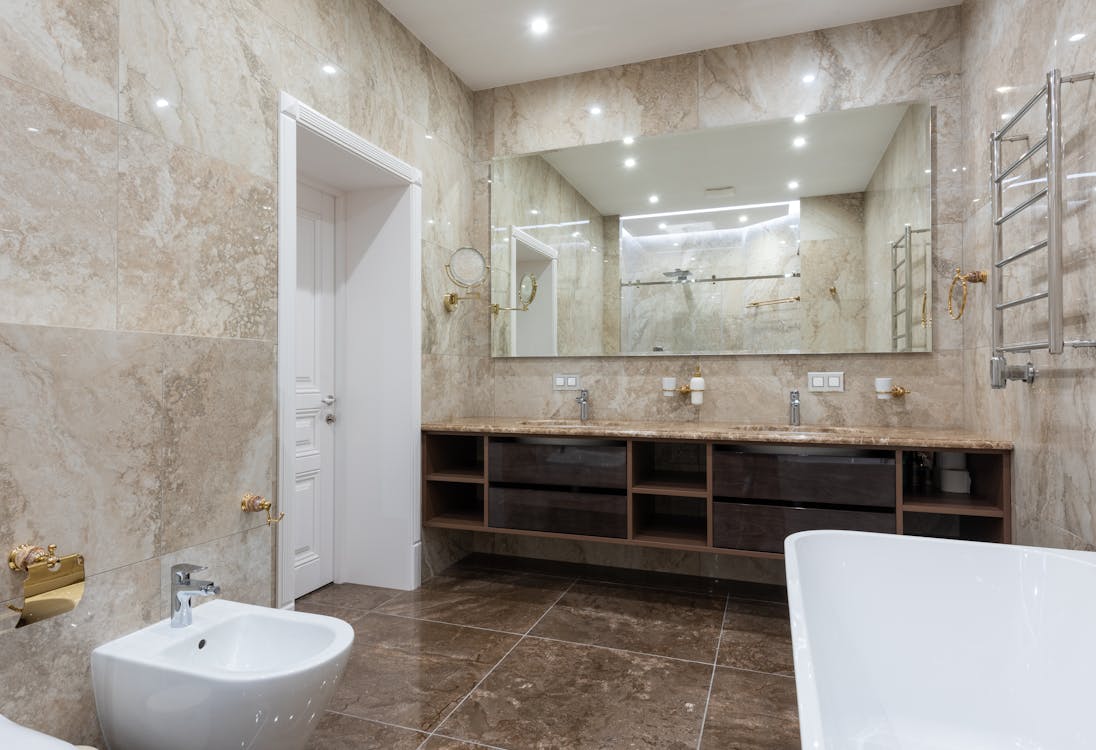
The finishing touches are the final details that will bring your bathroom design together and make it feel complete. These touches add personality and enhance the overall aesthetic of the space. Here are some ideas to consider:
Mirrors and Lighting Accents
- A mirror is an essential element in any bathroom. Choose a mirror that complements the style of your bathroom and consider its size and shape. A large mirror can make a small bathroom feel more spacious.
- Lighting plays a crucial role in creating the right ambiance in your bathroom. Consider using sconces or pendant lights on either side of the mirror for task lighting. Additionally, a dimmer switch can allow you to adjust the lighting according to your needs and create a relaxing atmosphere.
Decorative Elements
Adding decorative elements can make your bathroom design feel more inviting and visually interesting. Consider incorporating items like:
- Plants: Plants can breathe life into any space, including bathrooms. Choose low-maintenance plants that thrive in humid environments, such as ferns or pothos.
- Artwork: Hang a piece of artwork that complements the color scheme and style of your bathroom. Abstract or nature-inspired prints are popular choices.
- Decorative trays and vases: Place decorative trays on your countertop or vanity to corral small items like soap or toiletries. Add a vase with fresh flowers for a pop of color.
Window Coverings
Privacy is important in the bathroom, but that doesn’t mean you can’t have stylish window coverings. Consider these options:
- Blinds or shades: Choose moisture-resistant blinds or shades that provide privacy while allowing natural light to filter through.
- Sheer curtains: If you have a window that doesn’t face a direct line of sight, sheer curtains can add a touch of elegance while still allowing natural light to come in.
Remember, the finishing touches should reflect your personal style and preferences. Don’t be afraid to get creative and add elements that make you happy every time you step into your newly designed bathroom.
“The devil is in the detail” – Ludwig Mies van der Rohe
Also Read: Bringing Luxury to Your Bathroom : Design Tips for Homeowners in 2023
Conclusion
Transforming your bathroom into a fresh and rejuvenating space is an exciting endeavor. By assessing your current bathroom design, setting a budget, choosing a style and theme, considering the layout and floor plan, selecting a color palette and materials, optimizing lighting and ventilation, finding storage solutions, selecting fixtures and fittings, deciding on flooring and wall decor, and adding finishing touches, you can create a bathroom that is both functional and beautiful.
Remember, the key to a successful bathroom renovation is careful planning and attention to detail. Take the time to evaluate your space and identify any problem areas. Consider your needs and preferences when designing the layout and floor plan. Think about the overall aesthetic of your home and choose a style and theme that complements it. Select a color palette that creates a calming and inviting atmosphere, and pick materials that are not only stylish but also durable and easy to maintain.
Lighting and ventilation play a crucial role in creating a comfortable and functional bathroom design. Enhance natural lighting, choose appropriate light fixtures, and make sure the space is well-ventilated to prevent moisture buildup. Maximize storage space with clever organization ideas and incorporate stylish storage units that blend seamlessly with your bathroom design. When selecting fixtures and fittings, consider the sink and vanity options, toilet selection, and bathtub or shower choices that best suit your needs and personal style.
Flooring and wall decor can significantly impact the look and feel of your new bathroom design. Choose flooring materials and designs that are both stylish and water-resistant. Explore different wall decoration ideas, such as tiles, wallpaper, or paint, to add personality to your space. Finally, add the finishing touches with mirrors and lighting accents, decorative elements, and window coverings that enhance the overall ambiance of your bathroom design.
In conclusion, transforming your bathroom is a rewarding project that can breathe new life into your home. With careful planning, consideration of your needs and preferences, and attention to detail, you can create a fresh and inviting space that reflects your personal style. So why wait? Start envisioning your dream bathroom today and let the transformation begin!
Monetize the article
To make your bathroom transformation even more enjoyable and hassle-free, consider using high-quality bathroom fixtures and fittings from Arkitecture Today. They offer a wide range of products that combine functionality with contemporary design, ensuring that your bathroom renovation is not only visually stunning but also built to last. Check out their collection today and take the first step towards creating your dream bathroom!
Frequently Asked Questions
1. What are some popular bathroom design ideas for a fresh start?
Some popular bathroom design ideas for a fresh start include: 1. Minimalist design with sleek fixtures, 2. Spa-inspired bathrooms with natural elements like stone and wood, 3. Modern farmhouse style with vintage accents, 4. Contemporary design with bold colors and geometric patterns, and 5. Scandinavian design with clean lines and light colors.
2. How can I make my small bathroom appear larger?
To make a small bathroom appear larger, you can use light colors on walls and fixtures, install a large mirror to create an illusion of space, utilize storage solutions to declutter the area, and opt for a floating vanity to maximize floor space.
3. What are some budget-friendly bathroom design ideas?
Some budget-friendly bathroom design ideas include repainting walls or cabinets instead of replacing them, using affordable vinyl or laminate flooring, updating hardware and fixtures for a fresh look, and adding decorative elements like plants or artwork.
4. How can I create a spa-like atmosphere in my bathroom?
To create a spa-like atmosphere in your bathroom design, consider adding features such as a luxurious bathtub or rain shower, installing dimmable lighting for a relaxing ambiance, using natural materials like bamboo or pebble tiles, and incorporating soothing colors like blues and greens.
5. What are some eco-friendly bathroom design ideas?
Some eco-friendly bathroom design ideas include installing low-flow toilets and faucets to conserve water, using energy-efficient LED lighting, choosing sustainable materials like bamboo or recycled glass for countertops and tiles, and incorporating natural ventilation through windows or skylights.

